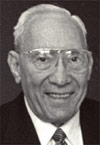Machines may rock, machines may stall, but the message running through every 2.007 contest is the same: engineering design is a playful, spiritual thing. The big fun is in helping someone else.
In this spirit, 2.007 emcee Alexander Slocum stopped the action at halftime to present a winner's trophy to Ernesto E. Blanco, adjunct professor of mechanical engineering.
Blanco "made me a mechanical engineer!" boomed Slocum, miked like a rock star. "I was at MIT. I was lost. What to study? Physics? Math? Bah! One day I was wandering the halls and I spotted this, this, drawing of a machine. It was Ernesto's drawing. It was an invention. I was home! And I've been here ever since. Thank you, thank you, from all of us."
Blanco accepted the trophy with characteristic quiet grace. Ditto, the deafening ovation. ("Schwing!" was his 25th 2.007 contest.)
But later, sitting in his office where portraits of his own inventions hang on the walls and a working model of a stair-climbing wheelchair springs to life with the flick of a switch, Blanco was all engineer, all about giving it away.
"Engineering is a service profession. It is about improving things for mankind," the Cuban-born inventor declared. "I come from a lesser-developed country. After my father died, our family knew scarcity. I started by inventing toy airplanes for myself, then an electric egg cooker. I moved on to inventing things that would help the country people, such as solar-cooled bins to store produce," Blanco recalled.
He studied at the Renssaeler Polytechnic Institute in Troy, N.Y., returned to Cuba to teach engineering at Havana University, then abandoned Cuba for good in 1960.
"I was a privileged person, associated with the United States. I was being followed. We had to leave. When the day came, I left my library, all my books, my house, everything. I left the breakfast dishes on the table. I said, 'Let the government wash them.' As we flew over the Florida Keys, I looked down and said, 'I am the happiest dispossesed person in the world.'''
Eventually, like Slocum in the Infinite Corridor, Blanco found a home at MIT. He met Robert W. Mann, the Whitaker Professor of Mechanical Engineering, emeritus. They lunched. They talked teaching. Blanco came to MIT, worked in industry and returned permanently to MIT just as 2.007, then known as 2.70, was gearing up.
Blanco considers Mann a mentor. "He was my biggest influence at MIT. He was interested in helping the handicapped and the blind. So was I. He changed my life," said Blanco.
In addition to the stair-climbing wheelchair, Blanco has invented a Braille reading machine ("old before its time"), numerous machines for textile manufacturing and an automatic page turner for musicians, among other things.
"The technology for the page turner was around in Leonardo da Vinci's time. Inventing is about using the knowledge we have inventively and creatively. That's why I like 2.007. We teach that physics belongs not only to books, it belongs to the world."
Blanco, a painter, believes that physics and engineering principles are most efficiently conveyed through drawing. He became an accomplished draftsman to support himself during his college years. At MIT, he once taught a whole lecture in Spanish to show how drawing communicated ideas completely.
"Drawing is universal. A machine drawn in any language is a complete communication," he said.
To illustrate, Blanco unrolled a sprawling, dark pearl gray sheet, dated 1980, depicting various views of an enormous, intricate device.
Was this the actual drawing that so inspired Slocum, his once-wandering student, now up to his mental snowboard in students and robots and pizza and pucks?
Blanco smiled and shook his head. "Inventors can't afford to be sentimental. It's too discouraging. We look to the future. We look to results. This is a machine to annihilate tumor cells. Would you like to learn how it works?"
A version of this article appeared in MIT Tech Talk on May 15, 2002.






